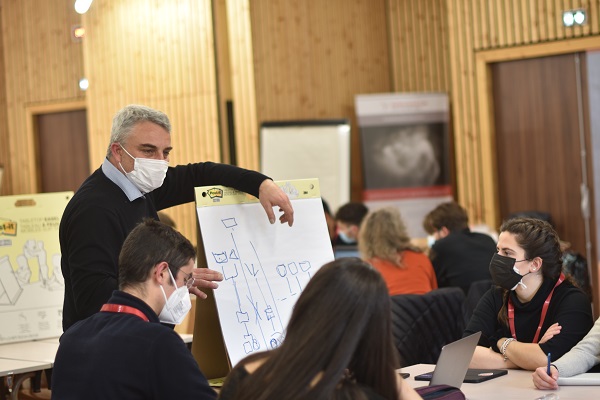Once again in 2022, Nanoelec’s Human Capital and Training Design programme designed and implemented a new training module on sustainable electronics with the Grenoble Institute of Technology (Grenoble-INP) and Grenoble Ecole de Management (GEM). For two half days, some 60 future manager and engineer students at GEM and Grenoble-INP as well as Erasmus European exchange students, worked hand in hand with professionals from STMicroelectronics and Akileo Formation, researchers from the French Alternative Energies and Atomic Energy Commission (CEA) and members of the Think What Matters collective. Youla Morfouli, teacher at Grenoble-INP, reports.
What design challenges do training programmes in sustainable electronics involve?
Our students tell us that, more than ever, they are in search of meaning; they are looking for jobs that make a true contribution to society. We must therefore adapt our training offers to this new demand. This is what we have been doing for the past three years with Nanoelec’s Human Capital and Training Design programme, by developing different modules that include a sustainable dimension.
What are the expectations of your industrial partners?
The microelectronics industry has a longstanding commitment to reducing its environmental impact across the entire life cycle of products. Our partners are convinced that microelectronics engineers and managers must now take action at their level, both as technologists with highly specialised skills and as responsible citizens, to control the impact of technologies, create new “eco-friendly instincts” and, on the whole, help to reduce humanity’s environmental footprint.
What is the outline of your educational programme?
A first session shed light on various technical subjects concerning the environmental impact of microelectronics. We are working on sustainable design concepts through a method that consists of integrating environmental parameters into the design and implementation of a manufacturing process.
The workshop also aims to build cross-cutting skills, for example by leading future engineers or managers to understand the complexity of the world and its scientific, ethical and political dimensions. This will enable them to become drivers of real change in attitudes and behaviours by proposing new ways of approaching and working on the issues facing their company.
How are you initiating a real educational change?
With this type of module, our students begin the semester by thinking about the future; they are encouraged to get involved as a driving force behind changes in the world. It’s also an opportunity to work directly with seasoned professionals who share their experience with the students and guide them in their thinking for two half days.
This was the workshop’s third year. How did it go?
After addressing the topic of smartphones and their lifecycle in 2020 and 2021, the 2022 event was dedicated to smart objects for smart buildings. The 54 students were split up into six groups and with the help of experts, each group worked concretely on different technical subjects around the starting scenario (transforming an office floor into a “smart floor” by using IoT technologies to cut energy costs (while reducing the overall carbon footprint) and improve the safety and comfort of employees ).
What surprised you in the final outcome of the work? What stood out?
The students found themselves in the shoes of engineers and managers, faced with practical problems similar to those found in the real industrial world. We were struck by the quality of the discussions they had and their teamwork. They were highly motivated and committed, and they took a very pragmatic approach to the problems in order to develop real action plans.
What happens after the workshop?
One month after the workshop, the group of six students who won first place was able to visit and truly appreciate the exhibition “1000+ Solutions for Cities” created by the Solar Impulse Foundation and Schneider Electric, focusing on the themes of energy, buildings, waste, production and consumption, mobility and infrastructure.
And as a result of the ideas that emerged during the workshop, a second group very interested in the challenges of smart buildings and the contribution that microelectronics technology can make, decided to work throughout the entire semester on a project called “IoT for smart buildings”, with the help of the start-up Akileo Formation.
How will the training model subsequently be applied?
We are going to try to continue this experience by involving more students from diverse backgrounds and possibly lengthen the module format. This would allow more in-depth work and therefore ease the participants’ frustration at not being able to take their thinking and ideas further.
This year, the module focused on the design of a smart, adaptable and connected building. Excerpt from the scenario: “You are employees of the company “Green IoT for smart buildings”. With a view to the construction of a new office building, you must propose a prototype for the use of new technical management services and monitoring the occupancy rate (optimise room occupancy and the quality of the environment, anticipate energy consumption, etc.). You should integrate the use of artificial intelligence (AI) (powerful neural network embedded on a microcontroller) as much as possible in order to manage the IoT data (thermal, optical, chemical, etc. sensors)”.

During the workshop “Sustainable Electronics for Smart Buildings” 2022, by Nanoelec/CHIF program (c) Grenoble-INP




